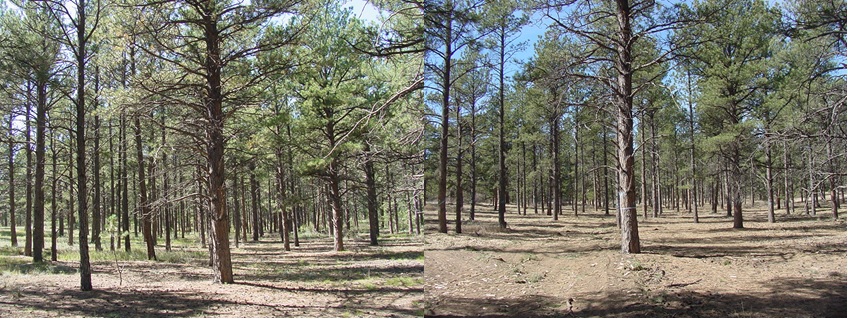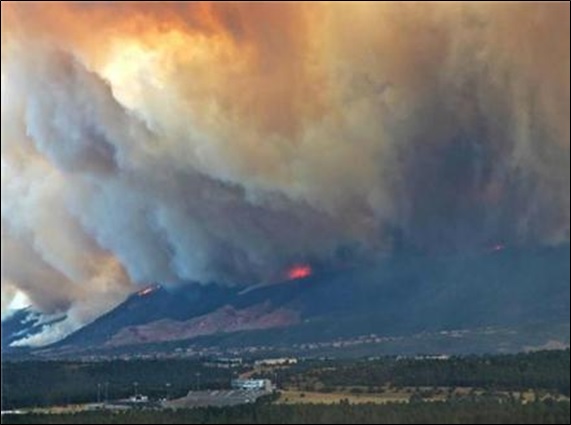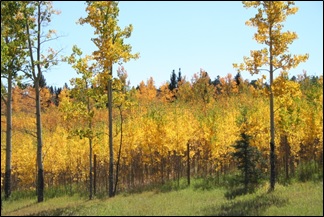Forestry and Fire
 provide for improved forest health, reduced risk of crown driven wildfires, and forest aesthetics. Forests that have low densities and fewer understory trees are are more characteristic of the open woodlands historically present in Colorado's Front Range. These randomly spaced open stands are healthier, tend to create reduced fire behavior, and are better able to repel the various insects and pests that feed on them. Regionally, the Academy partners with other land management agencies and organizations to achieve these same objectives on the greater Rampart Range/Monument Creek landscape.
provide for improved forest health, reduced risk of crown driven wildfires, and forest aesthetics. Forests that have low densities and fewer understory trees are are more characteristic of the open woodlands historically present in Colorado's Front Range. These randomly spaced open stands are healthier, tend to create reduced fire behavior, and are better able to repel the various insects and pests that feed on them. Regionally, the Academy partners with other land management agencies and organizations to achieve these same objectives on the greater Rampart Range/Monument Creek landscape.The Academy achieves the lower densities and fewer understory trees through a combination of mechanical and hand thinning, mastication, and prescribed fire. Byproducts of the thinning program and other tree removal projects on the Academy are sold as firewood through the Academy Natural Resources office. Information on the Academy's firewood program as well as more information on our forest and fire management program is found below.
Insects and Disease
Forests are habitat for many naturally occurring insects and diseases. While often called "pests" these insects and diseases often persist at endemic levels without causing widespread mortality. Weakened or stressed trees and the alignment of ideal climatic variables can cause insect and disease populations to reach epidemic levels where widespread mortality can degrade the visual environment and cause a cascade of impacts to water and nutrient cycling, wildlife habitat suitability and wildfire threat.
Ips
The last decade has brought periods of drought to the Front Range of Colorado, and this has resulted in an increase in Ips engraver beetle activity. Ips beetles are in a family of insects called "bark beetles". Adult bark beetles lay their eggs beneath the bark of trees, and the young beetles, called larvae, create a network of galleries in a thin layer of tissue that transports nutrients in the tree. The collective damage from the galleries can kill the tree if enough beetle larvae are present. Multiple generations of Ips beetles can hatch within one summer, resulting in rapid increases in populations if suitable conditions exist.
Various species of Ips beetles live in small diameter conifers or the canopies of larger diameter conifers and kill or wound the Academy's ponderosa pine, spruce, Douglas-fir and white fir. Over the past few years, the Academy has actively removed thousands of infected trees as soon as they are located in order to prevent the build-up in populations. While the majority of impacted stands were thinned to densities that will make them more resilient to Ips beetles, the increases of vigor to the stand may take years to realize. The Academy continues to monitor Ips populations and mitigate infected trees. The Academy's Natural Resources office is also partnering with Air Force Academy Cadets to improve the monitoring of Ips populations. These effots have proven successful in drastically reducing the beetle mortality in conifers.
Western Spruce Budworm
Defoliating moths have recently begun to impact the forests of the of greater Rampart Range/Monument Creek landscape. One of these moth species is present on the Academy and Farish, and is currently causing defoliation of spruce, fir, and Douglas-fir. Western Spruce Budworm larvae emerge in the spring and consume the last year or more's new growth. Like the Ips beetle, multiple generations can occur within a year. When populations increase and defoliations continue for multiple years, mortality can occur.
At present, mortality from Western Spruce Budworm is limited on the Academy and Farish. North facing slopes on the upper-elevations on the Academy are being defoliated and some mortality is occurring. At Farish, populations are small, but increasing, and mortality from Western Spruce Budworm has not been observed. While the population is cyclical, the Academy is planning projects that will increase the vigor of trees in impacted stands and reduce understory trees that are necessary for the Western Spruce Budworm to complete it's life cycle.
Wildfire
 shaped by frequent, low intensity fire. This resulted in open stand conditions and favored fire-resistant species such as ponderosa pine and Douglas-fir that have thick cork-like bark. On some slopes and certain elevations, less frequent, high intensity fire favored fire-resilient species that rapidly resprout following a fire such as quaking aspen and gambel oak. Fire suppression over the past century has been fairly successful at keeping fires small. This resulted in widespread increases in surface fuel and ladder fuel loading in lower elevation forests, which would have otherwise been consumed by the frequent low intensity fire. These altered stands are now at much greater risk to burning at a high intensity, which would have many undesirable effects to communities, the visual landscape, watersheds, and certain wildlife species. Past wildfires on and near the Academy have disrupted training exercises and resulted in the closure and evacuation of residents and employees. Each year many small fires occur from lightning strikes, training exercises, or arson, but these fires are quickly suppressed.
shaped by frequent, low intensity fire. This resulted in open stand conditions and favored fire-resistant species such as ponderosa pine and Douglas-fir that have thick cork-like bark. On some slopes and certain elevations, less frequent, high intensity fire favored fire-resilient species that rapidly resprout following a fire such as quaking aspen and gambel oak. Fire suppression over the past century has been fairly successful at keeping fires small. This resulted in widespread increases in surface fuel and ladder fuel loading in lower elevation forests, which would have otherwise been consumed by the frequent low intensity fire. These altered stands are now at much greater risk to burning at a high intensity, which would have many undesirable effects to communities, the visual landscape, watersheds, and certain wildlife species. Past wildfires on and near the Academy have disrupted training exercises and resulted in the closure and evacuation of residents and employees. Each year many small fires occur from lightning strikes, training exercises, or arson, but these fires are quickly suppressed.The Natural Resources offices and Fire and Emergency Services have been working together to reduce the threat of fire to the Academy. Each year, hundreds of acres of the Academy receive fuels reduction treatment, through mechanical or hand treatments and in some cases using prescribed fire. Fire and Emergency Services and the Natural Resources have been working with Academy residents to reduce fuels next to homes and structures, and provide education to residents about fire safety and preparation. The Academy is recognized for our forest and fuels management efforts by the Arbor Day Foundation as a Tree City USA and by the National Fire Protection Association as a Firewise Community®.
Reforestation & Regeneration
The Academy relies on natural regeneration and on-site seedling transplanting projects to maintain its forested areas. With the current overstocking and change in stand conditions, the natural regeneration from standing seed sources provides an abundance of new seedlings. The natural regeneration will be kept in check with fuels mitigation projects and prescribed fire where possible. Reducing the density of the seedlings will lessen competition and help produce a more resilient forest landscape. Transplanting projects will take existing seedlings and replant them in recreation areas such as lakes and trails.
transplanting projects to maintain its forested areas. With the current overstocking and change in stand conditions, the natural regeneration from standing seed sources provides an abundance of new seedlings. The natural regeneration will be kept in check with fuels mitigation projects and prescribed fire where possible. Reducing the density of the seedlings will lessen competition and help produce a more resilient forest landscape. Transplanting projects will take existing seedlings and replant them in recreation areas such as lakes and trails.
Increasing temperatures and altered precipitation are causing rapid changes in the forest. We expect to lose the majority of the spruce and fir trees. They prefer the colder and wetter habitat which is rapidly decreasing at USAFA.
At Farish, stands of quaking aspen are reaching maturity and beginning to reach their age limit and die. To maintain and enhance these stands, the Academy has established several small regeneration units where the disturbance of cutting has encouraged aspen sprouting. Today, these regeneration stands are fenced to protect them from elk damage. When the regeneration stands reach suitable diameter and height, the fencing will be removed. Additional harvest units will be added in the future to maintain a diversity of age classes.
Urban Forestry
The Academy is home to a large variety of urban trees of various species. An urban tree is different from our native forests in that they serve a largely decorative purpose and provide shade and character near the Academy's buildings and roads. Many of these species are considered ornamental varieties of trees native to areas outside of the Academy. Each year, the Academy through both the Grounds Maintenance and the Natural Resources monitors and maintains these trees in a healthy condition.
The health of this urban forest is dependent upon receiving adequate water through irrigation, pruning trees to maintain healthy form, providing mulch to protect roots and prevent mower damage, and maintaining vigilance for biotic threats that could damage the trees.
Fire Protection
The US Air Force Academy implements a robust fire protection and fuels reduction program. Shaded fuels breaks on the southern and northern boundary were installed in 2017 to provide 100’ of defensible space. This project, along with the railroad and interstate 25, provide installation protection and a defensible line along USFA’s boundaries. Our western boundary will be protected through a series of fuels reduction projects and strategic fireline construction.
To combat overstocked and unhealthy forests, Natural Resources develops a series of overstory thinnings to reduce competition, create proper spacing, reduce the effects of forest pests, improve forest health, and decrease the chances of a crown driven wildfire from threatening the area by removing a selection of overstory trees. These areas are chosen based on current stand conditions, presence of forest pests or disease, and location. Stands near sensitive areas such as the Doug Valley and Pine Valley Housing.
Fuels mitigation is reducing the amount, composition, and structure of burnable material in the mid to under story. These projects are completed either by hand or by a tracked or wheeled machine with a masticating head attachment. The masticating head on the machine is able to reduce the material to mulch size and remove chances of that vegetation carrying fire into the overstory trees. Hand treatments will result in debris piles that will need to be burned with future prescribed fire operations.
The goal of all treatments is to create areas of defensible space from the installation as a whole to forested stands to individual structures. Properly constructed and managed defensible space has been proven to greatly increase the chances of a structure’s survivability in the event of a wildfire. Natural Resources works with the Wildland Support Module and 10 CES Fire and Emergency Services to complete defensible space projects on select structures throughout USAFA.
Prescribed fire is also an essential management tool. Where possible USAFA is working to create a resilient forest landscape with properly spaced trees managed by prescribed fire. The Front Range of Colorado is a fire dependent landscape. The reduction of fire on the landscape increases fuel loading and deteriorates the health of the forest. It is also a natural more cost-effective process to properly manage forested areas where possible. Natural Resources works with the Wildland Support Module and 10 CES Fire and Emergency Services to identify, prepare, and implement prescribed fire operations based on comprehensive burn plans.